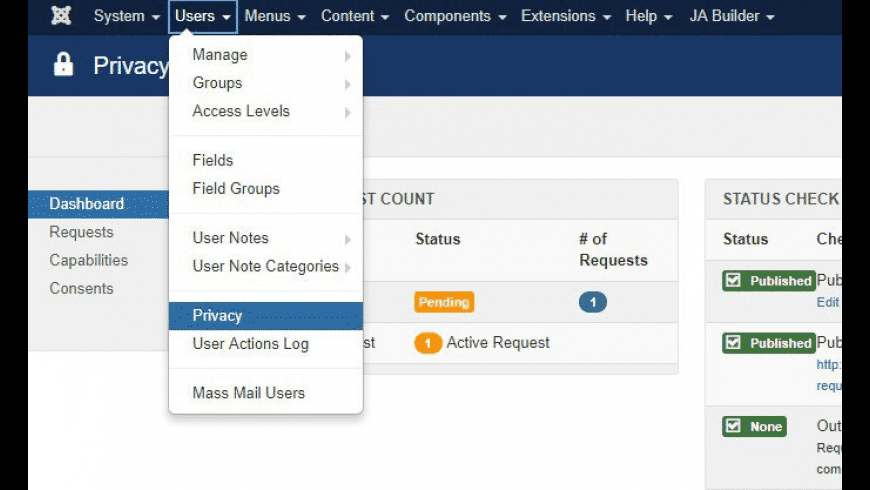From Joomla! Documentation
- The Flexible Platform Empowering Website Creators. 4.0.3 Released on Tuesday, 14 September 2021 07:06 Release Announcement.
- Packaged by Bitnami Installers Bitnami native installers automate the setup of a Bitnami application stack on Windows, Mac OS and Linux. Each installer includes all of the software necessary to run out of the box (the stack). The process is simple; just download, click next-next-next and you are done!
- NOTE: Starting with Artisteer 4.2 it is not possible, to export Joomla, Wordpress and Drupal themes in trial mode. Artisteer 4.3 for Windows can be downloaded by clicking here. Download Artisteer for Windows.
Is the mobile-ready and user-friendly way to build your website. Choose from thousands of features and designs. Is free and open source. Download Joomla! Download Joomla! Download and Install Joomla! In your own server or development environment.
(Redirected from Xampp)
- 1Introduction
- 1.2Installation on Linux
- 1.3Installation on Mac OS X
Introduction
XAMPP is an easy-to-install package that bundles the Apache web server, PHP, XDEBUG, and the MySQL database. This allows you to create the environment you need to run Joomla! on your local machine. The latest version of XAMPP is available at the XAMPP web site. Downloads are available for Linux, Windows, Mac OS X and Solaris. Download the package for your platform.
Joomla 3
Important Note Regarding XAMPP and Skype: Apache and Skype both use port 80 as an alternative for incoming connections. If you use Skype, go into the Tools-Options-Advanced-Connection panel and deselect the 'Use 80 and 443 as alternatives for incoming connections' option. If Apache starts as a service, it will take 80 before Skype starts and you will not see a problem. But, to be safe, disable the option in Skype.
Installation on Windows
Installation for Windows is very simple. You can use the XAMPP installer executable (for example, 'xampp-windows-x64-7.4.4-0-VC15-installer.exe'). Detailed installation instructions for Windows are available here.
If you are on Windows XP or 2003 they are not supported by the main package but there are compatible versions of XAMPP for these platforms listed on the download page (but you will only be able to run PHP 5.4 or lower - and therefore will only be able to test Joomla 3.x and lower).
For Windows, it is recommended to install XAMPP in 'c:xampp' (not in 'c:program files'). If you do this, your Joomla! (and any other local web site folders) will go into the folder 'c:xampphtdocs'. (By convention, all web content goes under the 'htdocs' folder.)
If you have multiple http servers (like IIS) you can change the xampp listening port. In <xamppDir>apacheconfhttpd.conf, modify the line Listen 80 to Listen [portnumber] (ex: 'Listen 8080').
You can find a detailed tutorial on installing XAMPP on Windows, along with the Joomla 4 Beta, the Joomla Patch Tester and Git in this Joomla Community Magazine article.

Installation on Linux
Install XAMPP
Open Terminal and enter:
(replace xampp-linux-1.7.7.tar.gz with the version of xammp you downloaded).It has been reported that the MYSQL database of xampp 1.7.4 does not work with Joomla 1.5.22
This installs ... Apache2, mysql and php5 as well as an ftp server.
and
starts/stops all the services
Test your XAMPP localhost server
Open your Browser and point it to
The index.php will redirect to
There you will find instructions on how to change default usernames/passwords. On a PC that does not serve files to the Internet or LAN then changing the defaults is a personal decision.
Get Joomla
Download the latest Joomla instalation zip [1]
Unzip to your hard drive
Connect to localhost with an FTP client Default
Create a folder for your Joomla on the localhost server
FTP the unpacked Joomla installation files to the newly created Joomla folder.
Important:
- The xammp installation sets the correct Ownership of the files and permissions.
- Using the CHOWN command will cause Ownership problems with xampp.
- Using nautilus to manipulate folders/files on localhost will cause Ownership problems with xampp.
Database info
Host
Default Database name
Default Database user
There is no default Password.
Administrator password is your choice.
Installing Sample Data is recommended for the novice user.
After installation delete the installation directory and point your Browser to:

or
Creating a link in the Ubuntu menu
To create a GUI for xammp connected to your Ubuntu menu
Open up the Terminal and type
Then copy the following into the gedit and save.
If the control panel fails to launch, try running the Exec command directly in the terminal:
If you receive the error:

Install the missing libraries:
XDebug PHP debugger
The XAMPP package for Linux does not includes the XDebug PHP debugger. To install XDebug on Debian or Ubuntu:
- Install the build-essential package:
- Download the development package for your version of XAMPP and extract it over your existing installation:
- Build XDebug:
Joomla Version
After this you will have following output on your console…
Then the output will be this.. please monitor the directory specified.
Create a folder in your temp folder that will holds the data file generated by XDebug:
Alternative installations:
Install using PHP extensions community library (PECL) bundled with xampp:
On Ubuntu/Debian you can install using:
Joomla Download Free
(warning: this will also install Apache and PHP from apt repositories).
Warning for 64bit users
When compiling XDebug or installing via apt-get, you will receive an error when (re)starting xampp:
This is because xampp runs 32bit but XDebug is 64bit. To overcome this problem, either make xdebug.so on a 32bit machine or download it from:
Joomla Software Download
Download the file: 'PHP Remote Debugging Client' for 'Linux (x86)'Extract the content of the file on your computer, this compressed file contains several folders with version numbers ex: 4.4, 5.0, 5.1 ... 5.3 and so forth, get in the folder with the higher version number or the one that works for you, then manually copy the file 'xdebug.so' to the following location, overwrite if needed
Remember this location could be different on your computer
Installation on Mac OS X
Mac OS X actually includes an Apache server out-of-the-box, but most developers will prefer to use the integrated tools and configurability provided by XAMPP.
As with most programs on Mac, installation is a breeze. Visit Apache Friends - Mac OS X for the universal binary download.
Once the file has finished downloading, just open the disk image, and drag the XAMPP folder to the 'Applications' folder alias.
To start the server, open 'XAMPP Control.app' and press the start button next to Apache.
A Little Troubleshooting
Many Mac users have a little difficulty at this stage when trying to set up another instance of Apache on their machine. If you cannot start XAMPP's Apache, you have two options:
You can change the listening port of XAMPP. In ApplicationsXAMPPxamppfilesetchttpd.conf, modify the line that says, 'Listen 80' to Listen [portNumber]. E.g.:
You can change the listening port of the pre-installed Apache server. In finder, go to '/etc' (CMD+SHIFT+G); from here you will be able to navigate through the normally hidden Apache files. Find the folder labeled Apache2, and edit the 'http.conf' file. Modify the line that says, 'Listen 80' to Listen [portNumber]. E.g.:
Note: If you choose to change the port of the pre-installed Apache server, you may need to restart your computer for changes to take effect. You will also have to authenticate as an administrator to change these files.
Test XAMPP Installation
Once XAMPP is installed and you have started the Apache service with the XAMPP Control Panel tool, you can test it by opening your browser and navigating to 'http://localhost'. You should see the XAMPP welcome screen similar to the one below.
Select the link called 'phpinfo()' in the top menu. This will display a long screen of information about the PHP configuration, as shown below.
At this point, XAMPP is installed successfully. Notice the 'Loaded Configuration File'. We will be editing this file in the next section to configure XDebug.